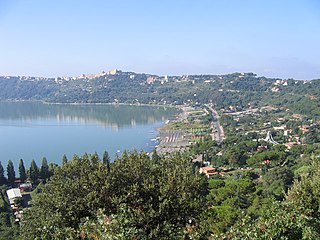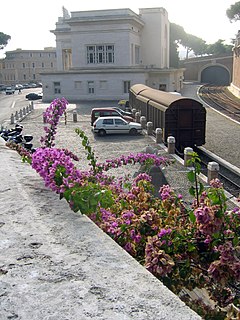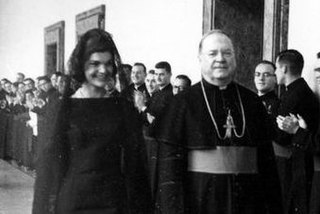The Vatican City State is a neutral nation, which has not engaged in any war since its formation in 1929 by the Lateran Treaty. It has no formal military compact or agreement with neighbouring Italy, although responsibility for defending the Vatican City from an international aggressor is likely to lie primarily with the Italian Armed Forces. Although the Vatican City State has never been at war, its forces were exposed to military aggression when it was bombed during World War II, and whilst defending Vatican property in Rome during the same conflict.

The Pontifical Gregorian University is a higher education ecclesiastical school located in Rome, Italy. It was originally a part of the Roman College founded in 1551 by Ignatius of Loyola, and included all grades of schooling. The university division of philosophy and theology of the Roman College was given Papal approval in 1556, making it the first university founded by the Society of Jesus (Jesuits). In 1584 the Roman College was given a grandiose new home by Pope Gregory XIII, after whom it was renamed. It was already making its mark not only in sacred but also in natural science.

Castel Gandolfo, colloquially just Castello in the Castelli Romani dialects, is a town located 25 kilometres (16 mi) southeast of Rome in the Lazio region of Italy. Occupying a height on the Alban Hills overlooking Lake Albano, Castel Gandolfo has a population of approximately 8,900 residents and is considered one of Italy's most scenic towns.

The Janiculum is a hill in western Rome, Italy. Although it is the second-tallest hill in the contemporary city of Rome, the Janiculum does not figure among the proverbial Seven Hills of Rome, being west of the Tiber and outside the boundaries of the ancient city.
The properties of the Holy See are regulated by the 1929 Lateran Treaty signed with the Kingdom of Italy. Although part of Italian territory, some of them enjoy immunities, similar to those of foreign embassies.

Trastevere is the 13th rione of Rome: it is identified by the initials R. XIII and it is located within the Municipio I. Its name comes from the Latin trans Tiberim, meaning literally "beyond the Tiber".

The Pontifical North American College is a Roman Catholic educational institution in Rome, Italy, that forms seminarians for priestly ministry in the dioceses of the United States and elsewhere, and that provides a residence for priests from the United States and elsewhere who are pursuing graduate studies or continuing formation programs in Rome. Oversight of the college is the responsibility of the Holy See's Congregation for the Clergy, which is delegated for most matters to the United States Conference of Catholic Bishops acting through the college's episcopal board of governors.
The Casa Santa Maria is a residence in Rome, Italy that serves English-speaking priests who are sent by their dioceses for graduate level studies in the city. It is a part of the Pontifical North American College, and served as its main campus from its founding in 1859 until the construction of a new campus on the Janiculum Hill in 1953. It also houses the Bishops' Office for United States Visitors to the Vatican.

The Villa Doria Pamphili is a seventeenth-century villa with what is today the largest landscaped public park in Rome, Italy. It is located in the quarter of Monteverde, on the Gianicolo, just outside the Porta San Pancrazio in the ancient walls of Rome where the ancient road of the Via Aurelia commences.

Monte Mario is the hill that rises in the north-west area of Rome (Italy), on the right bank of the Tiber, crossed by the Via Trionfale. It occupies part of Balduina, of the territory of Municipio Roma I, of Municipio Roma XIV and a small portion of Municipio Roma XV of Rome, thus including part of the Quarters Trionfale, Della Vittoria and Primavalle.

The Pontifical Urban University, also called the Urbaniana after its names in both Latin and Italian, is a pontifical university under the authority of the Congregation for the Evangelization of Peoples. The university's mission is to train priests, religious brothers and sisters, and lay people for service as missionaries. Its campus is located on the Janiculum Hill in Rome, on extraterritorial property of the Holy See.

The Vatican Railway was opened in 1934 to serve Vatican City and its only station, Vatican City. The main rail tracks are standard gauge and 300 metres (980 ft) long, with two freight sidings, making it the shortest national railway system in the world. Access to the Italian rail network is over a viaduct to Roma San Pietro railway station, and is guaranteed by the Lateran Treaty dating from 1929. The tracks and station were constructed during the reign of Pope Pius XI, shortly after the treaty.

Martin John O'Connor was an American prelate of the Roman Catholic Church. He served as rector of the Pontifical North American College from 1946–1964 and president of the Pontifical Council for Social Communications from 1948–1971.

Giovanni Simeoni was an Italian Cardinal of the Roman Catholic Church who served as Prefect of the Sacred Congregation for Propagation of the Faith from 1878 until his death, and was elevated to the cardinalate in 1875.

The Roman Colleges, also referred to as the Pontifical Colleges in Rome, are institutions established and maintained in Rome for the education of future ecclesiastics of the Roman Catholic Church. Traditionally many were for students of a particular nationality. The colleges are halls of residence in which the students follow the usual seminary exercises of piety, study in private, and review the subjects treated in class. In some colleges there are special courses of instruction but the regular courses in philosophy and theology are given in a few large central institutions, such as Pontifical Urbaniana University, the Pontifical Gregorian University, the Pontifical Lateran University, and the Pontifical University of Saint Thomas Aquinas, Angelicum.

Villa Lante al Gianicolo is a villa in Rome on the Janiculum Hill (Gianicolo). It is a summer house designed by Giulio Romano in 1520-21 for Baldassare Turini, as one of Romano's first independent commissions after the death of his master Raphael. The site was believed to have been that of the house of the Roman poet Martial, and the new villa was built on the same footprint as the surviving ruins, with a spectacular view facing Rome. Today, the property is owned by the Republic of Finland through Senate Properties, and the building houses the Institutum Romanum Finlandiae and the Embassy of Finland to the Holy See.

Charlotte Bonaparte Gabrielli was a French Napoleonic princess and the eldest daughter of Lucien Bonaparte and Christine Boyer. She became princess Gabrielli following her marriage to Mario Gabrielli, prince of Prossedi and Roccasecca, duke of Pisterzo. In Italy, she was known as Carlotta.

The Janiculum walls are a stretch of defensive walls erected in 1643 by Pope Urban VIII as a completion of the Leonine wall and for a better protection of the area of Rome rising on the right bank of the Tiber.
The Ukrainian Pontifical College of Saint Josaphat is a Pontifical College in Rome, for seminarians and priests of the Ukrainian Greek Catholic Church. Its patron saint is Josaphat Kuntsevych. It also includes the church of San Giosafat al Gianicolo, one of Ukraine's national churches in Rome.

The following outline is provided as an overview of and topical guide to Rome:
















